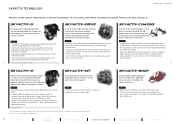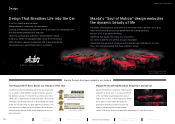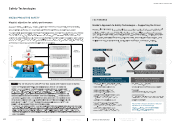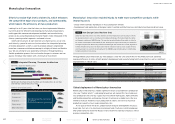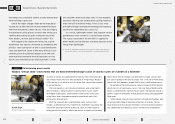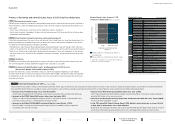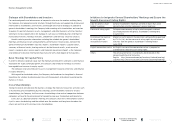Mazda 2016 Annual Report Download - page 28
Download and view the complete annual report
Please find page 28 of the 2016 Mazda annual report below. You can navigate through the pages in the report by either clicking on the pages listed below, or by using the keyword search tool below to find specific information within the annual report.
The new MX-5 was designed with the frame as a pack-
age around the occupants to give a strong sense of
oneness with the car and the driver a feeling that he or
she is controlling the car by will alone. To position the
driver at the center of the car and closer to the road,
the occupants are 15 millimeters closer to the center
and 20 millimeters lower than in the previous model.
To achieve an ideal driving position, the transmission
needed to be small and structurally simple to fit into a
limited space. The layout of the various elements in the
car was extremely difficult to design; the position of the
clutch pedal could not be off by even a few millimeters,
with the seat layout as close to the center as possible,
and the parking brake lever and steering wheel were
also positioned to achieve driving pleasure.
Katsuaki Nobukawa of the Powertrain Development
Division recalls:
“No one involved in the development would give in
easily on what they considered to be ideal for the
technological area for which they were responsible.
This was not because of the engineers’ egos — it was
more of a sense of responsibility as a parent giving
birth to the new MX-5. Heated discussions continued
for several days, with people making such comments
A Transmission That Embodies
Jinba-ittai
Co-Creation by Development and
Manufacturing Divisions
Katsuaki
Nobukawa
Drivetrain development
engineer
as “giving up that one millimeter means it won’t be an
ideal MX-5.” Everyone racked their brains trying to
come up with better solutions, and they changed their
minds countless times. It was that intense.”
After numerous, repeated analyses, the develop-
ment team came up with the idea of a revolutionary
transmission case. Instead of using the traditional
concept of uniform thickness, the minimum-required
thickness in terms of strength, rigidity, and NVH*2
performance was used in a three-dimensional alloca-
tion of the necessary thickness in each place, and by
not building the exterior rib used to maintain rigidity
in conventional transmissions, the team aimed for a
Kouji
Furutani
Die-cast process production
technology engineer
Hirokazu
Oishi
Die-cast mold production
technology engineer
Positioning the occupants closer to the center of the vehicle than in the previous model
meant that the space for the transmission in the new MX-5 is significantly reduced
Ttains the fun, responsive drive of previous models, but it adds a new dimension of evolution
that is winning praise from customers around the world. To create
Jinba-ittai
or “horse and rider as one” that
expresses the MX-5 feel, a new six-gear, front-engine rear-wheel-drive SKYACTIV-MT (manual transmission) was
developed, and the allocation of functions among its structural components was revised from scratch.
This section introduces the co-creation of a lightweight, compact, and highly efficient transmission that
preserves the MX-5’s traditionally crisp shifting.
Development Divisions Manufacturing Divisions
MAZDA ANNUAL REPORT 2016
26 Drivers of Value Creation
Message from
Management
Review of Operations
Foundations Underpinning
Sustainable Growth
Financial Section
Contents



